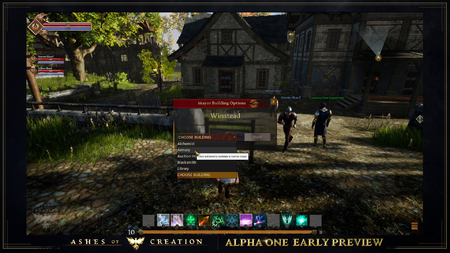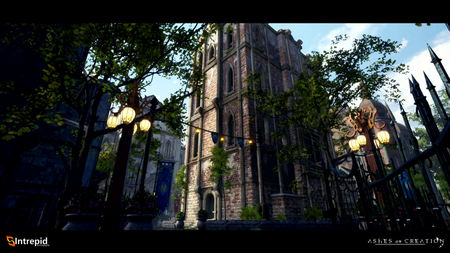Node layout and style
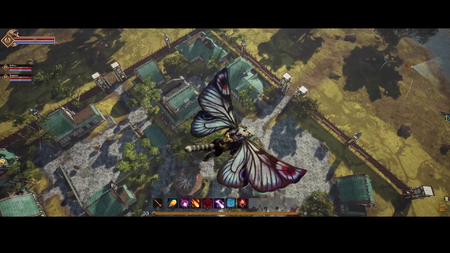
Já no terceiro estágio de evolução, como uma vila, é um layout razoavelmente grande; e parte desses layouts inclui domicílos essencialmente estáticos, dentro da base, que os jogadores podem comprar.[1] – Steven Sharif
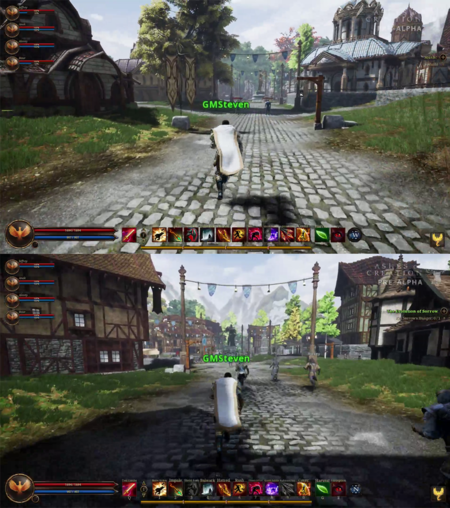
O layout e a arquitetura dentro da área de desenvolvimento de uma Base são determinados pela raça com mais influência. Por exemplo, uma Base em estágio 3 onde a maioria dos jogadores contribuíntes é Py'Rai terá uma vila Py'Rai com arquitetura Py'Rai. A maioria dos PNJs seriam elfos Py'Rai, e ofereceriam missões com narrativa Py'Rai.[3] – Margaret Krohn
A experiência contribuída por cada jogador é marcada com sua raça e outros identificadores. Quando uma Base evolui, a raça com a maior contribuição de experiência determina o estilo e cultura da Base. Essa mudança de estilo e cultura pode ocorrer em todo Estágio de Base. Por exemplo, se uma Base avança para o Estágio 2 - Acampamento e 51% de toda a experiência veio de jogadores Ren'Kai, a Base será uma Base Ren'Kai Estágio 2. Se essa mesma Base avançar para o Estágio 3 - Vilarejo, mas dessa vez os Py'rai tiverem contribuído 62% de tpda a experiência obtida, a Base se tornará uma Base Py'Rai Estágio 3. Influências culturais trazem mudanças além da estética e das missões - benefícios são dados àqueles da cultura dominante dentro da Zona de Influência daquela Base.[4] – Margaret Krohn
O layout e o estilo de uma Base são determinados por diversos fatores:[5]
- Localização da base.[5]
- Tipo de Base.[5]
- Raça que mais contribuiu para a evolução da Base.[5][6]
- Aparências raciais dos prédios e dos PNJs de uma Base.[7][6]
- Isso se aplica a todas as bases, incluindo bases de castelo.[8]
- O resto é determinado pelo prefeito da base.[5]
Algumas partes são determinadas pela área onde a base está. Outras, pelo tipo da base; certas partes são determinadas pela raça, e o resto é determinado pelo prefeito.[5] – Jeffrey Bard
Todas as bases, sejam elas relacionadas aos castelos ou não, têm influências culturais que são replicadas nas aparências dos prédios e dos PNJs presentes na Base.[8] – Steven Sharif
Existe uma mecânica de atrito que afeta a experiência e influência para impedir que uma única raça domine o mundo inteiro.[9]
Existe um atrito e esse atrito na experiência e influência aumenta de acordo com a performance da raça no mundo. Então se todas as bases forem de Orc, o nível de atrito deles será muito alto para competir com outras raças na hora de estabelecer a cultura de novas bases. Isso acontece pois já são muito influentes e existe uma opinião popular contra eles nas regiões que não influenciam.[9] – Steven Sharif
Edificações de Base
Governos de base decidem a localização e os tipos de edificações de base construíveis a serem colocadas nos setores de uma base.[12][13][14]
Essas são edificações que o prefeito pode controlar se serão construídas ou não. Edificações construíveis podem ser escolhidas em um dos espaços de terra que uma base recebe quando evolui. Se escolherem começar a construção de um desses tipos de edificações - uma das quais é o mercado -, receberão certos benefícios de comércio assim como quiosques que os cidadãos podem alugar.[15] – Steven Sharif
Quando os tipos de edificação são determinados, a comunidade precisará angariar recursos para a base (usando caravanas) e se unir para construir as edificações (através de missões e etc).[12]
O governo decide como especializar sua base. Ao fazerem certas escolhas, não poderão fazer outras.[12]
Governos diferentes poderão mudar as edificações em uma base.[12]
E pode ocorrer uma mudança de regime... Se alguém não gostar de terem construído um mercado e quiserem eleger um novo governo no próximo cíclo, eles podem...e aquele mercado poderia ser destruído e algo novo construído em seu lugar.[12]
Parâmetros predefinidos limitam o número de edificações dentro de bases.[13]
Edificações Únicas de Base
Cada tipo de base tem uma edificação única de base que pode ser ativada no Estágio de Vilarejo da evolução de base. A contrução única tem um papel central no progresso da civilização de um servidor.[17]
Destruição de Prédios do Node
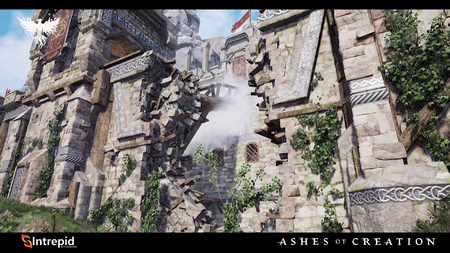
You could be more precision oriented in the decision to attack a city. Let's say it's a rival node that's trying to reach a node stage five or something and you want to disable their ability for the religious system to progress so you target the temple during the attack, or you want to disable their scholars academy from reaching a higher level so that your nodes can; or you want to disable multiple buildings that allow for experience and quests to be undertaken by its citizenship, which prevents them from keeping up in pace of experience gained with your node. These can be more precision oriented and don't have to effectualize an actual takeover of the node.[19] – Steven Sharif
Edificações de Base (including player housing) have hit points and can be damaged or destroyed by different systems.[20][21]
- NPC-driven events that are a response to story arcs or node atrophy.[20]
- Cercos de base and node wars.[20]
- Attackers may not be capable of destroying a node during a siege. Instead they may carry out precision attacks to disable specific service-oriented buildings within the node. These buildings can be targeted with siege weapons and bombs.[19]
- Hazardous events such as tornadoes or hurricanes.[22][20]
- Prefeitos have the ability to demolish constructed node buildings. This will have a node mandate cost and will require player buy-in via a vote.[23][24]
- Mayors will also have the ability, if they want, to demolish constructed buildings. So if they if they so choose they can destroy a building if they don't think it's needed anymore. But this will have mandate cost and a player buy-in votes. So we want to make sure that [the] mayor can't just go and blow up the whole node if they're trying to grief or something. So this is very important and impactful decision.[23][24] – John Collins
If building maintenance is not paid, or a building is damaged as the result of an event or siege, the building will enter a state of disarray.[23][24] Any NPCs or services offered by that building will not be available until the building is repaired.[25][21]
- Players must contribute materials to repair disarrayed buildings and restore them to an operational state.[23][24][20][21][26]
If a node siege is successful, or if buildings otherwise take significant damage, they are destroyed and appear as rubble on the plot they occupied.[23][24][20]
- Node governments must clear any rubble on plots before any buildings can be reconstructed. Any prerequisites for the building reconstruction must be satisfied beforehand.[20]
- Buildings also live within a prerequisite system. So in order to build down the tech tree of what these buildings provide, as the node grows larger to access stronger building types, you may get a kink in that chain if it's destroyed and you'll have to stand that back up in order to support the service again.[20] – Steven Sharif
- If the node is destroyed by a node siege, the debris field will contain spoils that are lootable by attackers or defenders.[27][28][29][21][30][31]
- Residência de Jogadores that is destroyed during a node siege can no longer be sold.[32] Furnishing and decorations are retained and can be placed again later.[32][33][34]
Static housing development
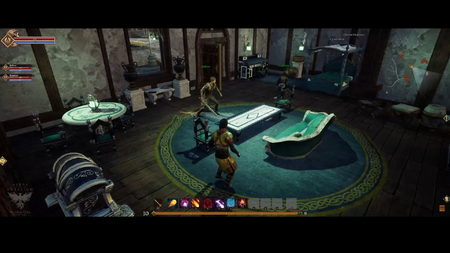
If the node advances players can essentially select an option on their house as they own it that they want it to upgrade to the next stage if the node advances or they can select an option not to upgrade it. So you as the node levels and larger homes become available, the town stage introduces additional medium types housing, the city stage introduces large sized homes, and in the metropolis stage introduces my mansion size houses each of which contain specific... allowances and allotments for different types of furnishings that have gameplay implications.[35] – Steven Sharif
In-node housing can scale in size with the advancement of its parent node. This may be toggled on or off by the player.[35][36]
- The Vilarejo stage offers small housing types.[35]
- The Município stage introduces medium housing types.[35]
- The Cidade stage introduces large sized homes.[35]
- The Metrópole stage introduces mansion size houses.[35]
If you choose to keep the same size then the next stage will have an occupied small home. So for instance if at stage three there are 8 small home and you own 1, then at stage 4 there are 10 new small homes of which x are owned by previous owners, and 10 new medium homes of which x are owned by upgraded small home owners.[37] – Steven Sharif
New property becomes available at each stage of advancement, but it will be more akin to what was available at the previous stage.[36]
- Only the houses that existed at the Vilarejo stage will become main street mansions at the Metrópole stage.[36]
Node redevelopment
A node that was successfully destroyed by a node siege may develop differently due to the following influences:[38][39]
- Different races becoming primary contributors.[38][39]
- Design elements determined by different governments.[38][39]
- Reactions and interactions with other nodes in the world.[38][39]
Artistic style
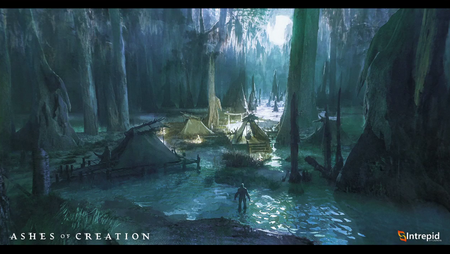
Part of the biome that the Ren'Kai are accustomed to is a more swamp or marsh oriented, so they have these almost stilt-like foundations on some of the assets because they're intended to sit above that marsh.[40] – Steven Sharif
Ashes of Creation will have a higher graphical fidelity than most western games. It will not be too stylized or "cartoony".[41]
- We can push the limits a little bit on the graphical fidelity, especially using Unreal Engine 4... My desire was not to see very cartoony games. I'm not a big fan of highly stylized art.[41] – Steven Sharif
- It's not to say that people can't do steampunk well. I've enjoyed some steampunk stuff. I'm a very high fantasy oriented type of storyteller; and the inspiration for Ashes obviously comes from my pathfinder campaigns that I ran long ago; and those are always set in a high fantasy world. So it just compromises what I believe is the perspective of the storytelling in the environment.[42] – Steven Sharif
- Estúdios intrépidos does not use AI for art production.[43]
- We do not use AI for production, except in unique internal cases when communicating fast reference material.[43] – Steven Sharif
Artistic influences
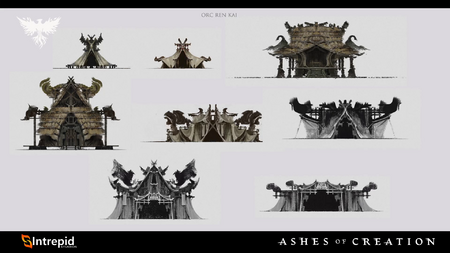
Character races are super important. These are the choices that we make at the onset of our adventure in an MMORPG: what race- not just mechanically aligns with our decisions, if those races have game mechanics behind them from a stat perspective, but visually and culturally and historically: What are these? What do these races represent? So it's important that visually they're distinct. And everyone's seen fantasy games do Elves, so everyone's seen them do Humans, everyone's seen them do Orcs: There's an established expectation almost behind what these traditional fantasy races represent; and there's a risk, because whenever you're creating a new IP or a new story or a new world- a new Universe; a realm in which things don't have to always be the norm, you can take a little bit of creative liberty to redefine some of the aspects of a particular race; and that can be a good thing, because it's something that is new to players. It's something that is unique to the realm that we're building- the surroundings that you have. So what we wanted to do was push a little bit more on the unique side of what the Py'rai would look like from a visual perspective.[45] – Steven Sharif
- Aelean architecture has a French medieval influence.[46]
- Dünir have a Nordic cultural influence.[47]
- Empyreans have a Greco-Roman imperialistic feeling.[48]
- The Kaelar have a European influence.[49]
- The Niküa have a Polynesian influence.[50][48]
- The Py'Rai have a Navajo Native American influence.[48] Py'Rai architecture has a woodland inspiration.[51][52]
- Pyrian architecture has a Greco-Roman influence.[53]
- Ren'Kai architecture has an Asian influence.[44]
- The Vaelune have a Middle Eastern influence.[54]
- The Vek have a Mesoamerican influence.[54]
- You will see in the different races that are available from a player character standpoint a lot of different influences that reflect many cultures in the world: Not just European, not just Africa, not Mesoamerican. These cultures are going to be present in many of the races.[55] – Steven Sharif
- The idea is just to find a base component in the real world as a starting point and then to begin to fantasize.[46] – Steven Sharif
Ver também
Referências
- ↑ 1.0 1.1 Transmissão ao vivo, 2020-06-26 (45:32).
- ↑ Transmissão ao vivo, 2018-02-09 (33:50).
- ↑ Blog - Know Your Nodes - The Basics.
- ↑ Blog - Know Your Nodes - Advance and Destroy.
- ↑ 5.0 5.1 5.2 5.3 5.4 5.5 Transmissão ao vivo, 2018-09-27 (53:06).
- ↑ 6.0 6.1 Entrevista, 2018-05-11 (54:34).
- ↑ Transmissão ao vivo, 2017-05-26 (21:23).
- ↑ 8.0 8.1 Entrevista, 2018-05-11 (47:27).
- ↑ 9.0 9.1 Entrevista, 2018-05-11 (1:00:19).
- ↑ Transmissão ao vivo, 2020-03-28 (1:16:03).
- ↑ Vídeo, 2020-03-23 (0:24).
- ↑ 12.0 12.1 12.2 12.3 12.4 Transmissão ao vivo, 2017-05-19 (33:57).
- ↑ 13.0 13.1 Transmissão ao vivo, 2018-01-20 (38:17).
- ↑ Transmissão ao vivo, 2018-04-8 (PM) (51:49).
- ↑ Entrevista, 2020-07-08 (55:05).
- ↑ Transmissão ao vivo, 2018-09-01 (36:28).
- ↑ Know Your Nodes: Economic Node Type.
- ↑ Transmissão ao vivo, 2019-10-31 (36:20).
- ↑ 19.0 19.1 Transmissão ao vivo, 2019-11-22 (16:56).
- ↑ 20.0 20.1 20.2 20.3 20.4 20.5 20.6 20.7 Transmissão ao vivo, 2022-03-31 (1:13:00).
- ↑ 21.0 21.1 21.2 21.3 Entrevista, 2020-07-08 (57:46).
- ↑ Forums - Livestream Q&A 2022-08-26.
- ↑ 23.0 23.1 23.2 23.3 23.4 Blog: Development Update with Village Node.
- ↑ 24.0 24.1 24.2 24.3 24.4 Transmissão ao vivo, 2023-08-31 (57:23).
- ↑ Entrevista, 2023-07-09 (1:32:45).
- ↑ Transmissão ao vivo, 2019-11-22 (17:59).
- ↑ Entrevista, 2023-07-09 (1:36:24).
- ↑ Transmissão ao vivo, 2022-10-14 (52:31).
- ↑ Podcast, 2021-09-29 (14:21).
- ↑ Transmissão ao vivo, 2020-04-30 (1:14:44).
- ↑

- ↑ 32.0 32.1 Transmissão ao vivo, 2020-06-26 (1:02:12).
- ↑ Transmissão ao vivo, 2017-07-18 (40:14).
- ↑ Transmissão ao vivo, 2017-11-17 (47:10).
- ↑ 35.0 35.1 35.2 35.3 35.4 35.5 35.6 Vídeo, 2020-05-31 (47:32).
- ↑ 36.0 36.1 36.2 Node series part II – the Metropolis.
- ↑

- ↑ 38.0 38.1 38.2 38.3 Transmissão ao vivo, 2020-10-30 (39:17).
- ↑ 39.0 39.1 39.2 39.3 Transmissão ao vivo, 2017-05-24 (52:39).
- ↑ 40.0 40.1 Transmissão ao vivo, 2022-02-25 (46:17).
- ↑ 41.0 41.1 Entrevista, 2018-10-20 (2:17:43).
- ↑ 42.0 42.1 Transmissão ao vivo, 2023-03-31 (1:17:42).
- ↑ 43.0 43.1

- ↑ 44.0 44.1 Transmissão ao vivo, 2019-10-31 (40:27).
- ↑ Transmissão ao vivo, 2022-02-25 (49:42).
- ↑ 46.0 46.1 Entrevista, 2018-10-20 (3:47:17).
- ↑

- ↑ 48.0 48.1 48.2 Entrevista, 2018-05-11 (1:03:21).
- ↑ Podcast, 2018-05-11 (31:35).
- ↑ Transmissão ao vivo, 2022-09-30 (1:08:24).
- ↑ Transmissão ao vivo, 2022-02-25 (44:28).
- ↑

- ↑ Transmissão ao vivo, 2017-10-16 (15:58).
- ↑ 54.0 54.1 Podcast, 2018-05-11 (31:35).
- ↑ Entrevista, 2018-05-11 (1:04:27).
